African penguins (Spheniscus demersus) are a fascinating penguin found along the southwestern coast of Africa. These endangered birds are known for their distinctive braying call, which sounds like a donkey.
In this article, we’ll share 15 interesting African penguin facts, from their diet and habitat to their burrows made from poop and same-sex partnerships. So, let’s delve in.
1. They are the only species of penguin found in Africa
Starting with the most obvious fact about African penguins, they live in Africa and are the only penguin species to breed there. They are found along the southern coast of Namibia and South Africa.
They breed at 28 different places on the continent. Outside of breeding season, they have been spotted as far north as Gabon, Mozambique, Congo, and Angola. They tend to stay within 20km of the shoreline although have been spotted as far as 100km away1 (source: IUCN).
All penguins live in the southern hemisphere, the below map shows where different species are located.
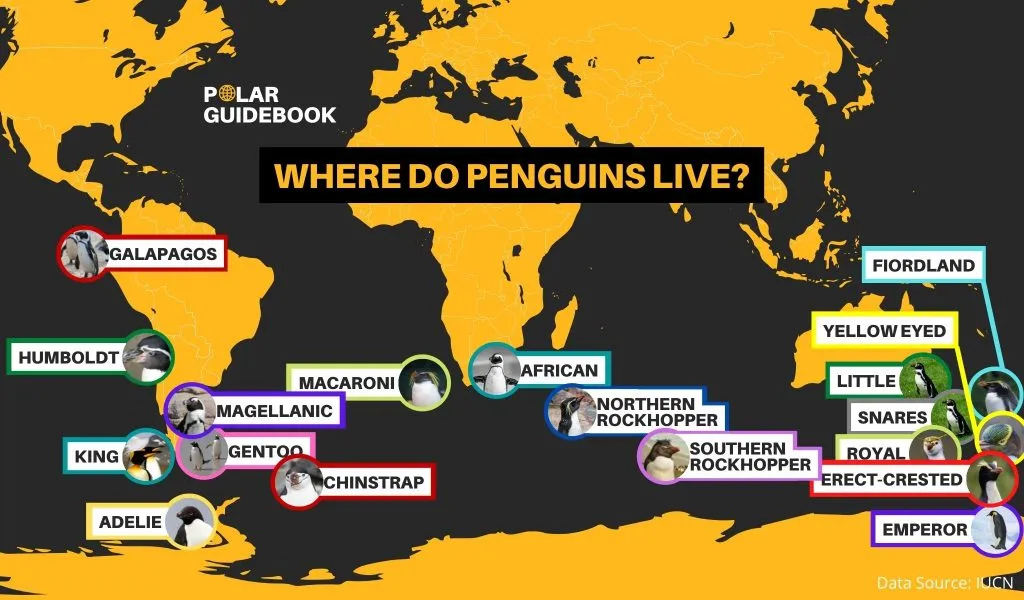

2. They are also known as the Jackass penguin
The scientific name for the African penguin is ‘Spheniscus demersus’. The first part comes from the ancient Greek word sphēn, meaning wedge, referring to the thin wedge shape flippers. The species name demersus is Latin meaning plunging, a reference to its diving behavior2 (source: Wikipedia).
African penguins have several other names which can cause confusion. Their other names are:
- Black-footed penguins – The name was coined In 1747 by English naturalist George Edwards who first spotted them. The name references the color of their feet, although they are not the only penguin with black feet.
ㅤ - Jackass penguins – due to their loud donkey-like call, although again they are not the only penguin with this call as it is similar to other banded penguins
ㅤ - Cape penguins – presumably because they have nesting sites across parts of the Western Cape province in Africa.
3. In the wild, African penguins have a lifespan between 15-20 years old
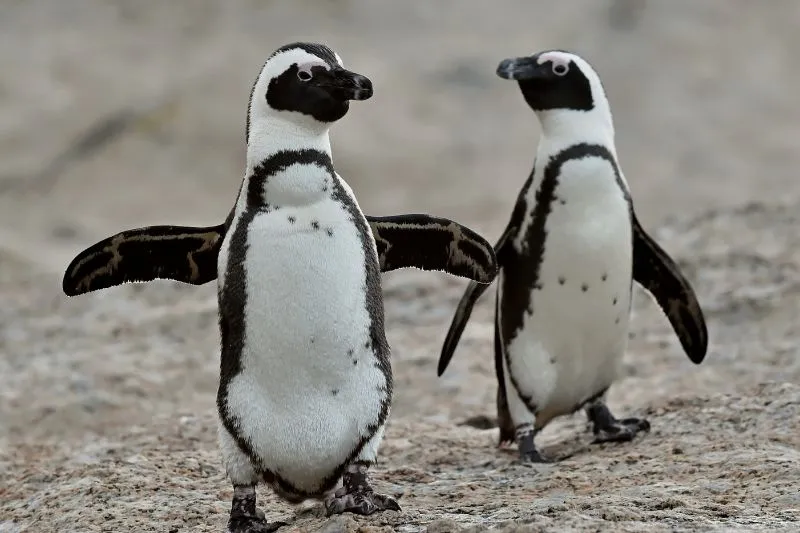
The lifespan of an African penguin in the wild is estimated to be between 15-20 years old.
On average, penguins have a lifespan of around 20 years so this is about average.
In captivity, penguins can live for much longer. Typically, penguins in zoos or aquariums live to around 30 years old.
The oldest known African penguin is ET who lives at Metro Richmond Zoo in Virginia. ET celebrated her 42nd birthday in 20223 (source: ABC News).
4. They are medium-sized penguins at 70cm tall
African penguins stand at 70cm (27”) tall which is average for a penguin. They are similar in size to other banded penguins such as the Humboldt and Magellanic penguins.
African Penguin usually weighs up to 3kg (7lbs)4 (source: Seaworld). See our full article to compare the size of penguins or check out the below graphic for a quick look.

5. There are just 41,700 African penguins left
Despite the total 30-31 million penguins left in the wild, just 41,700 of these are African penguins according to the latest estimates, and this number is decreasing rapidly.
Back in In the early 20th century, there were estimated to be anywhere between 1.5-3 million African penguins. That’s a 95% decline5 (source: The Conversation).
6. They are endangered
Erect-crested penguins are classified as endangered by the IUCN due to significant population declines. It’s thought that without conservation areas, they would already be extinct today6 (source: IUCN).
They are one of five endangered penguin species along with Yellow-eyed Penguins, Galapagos Penguins, Erect Crested Penguins, and Northern Rockhopper Penguins.
Egg poaching played a large role in the decreasing population of African Penguins, although this has now been made illegal. The lack of prey is a new threat facing African Penguins, this is due to the combined effect of climate change and industrial fishing which have depleted forage fish in areas where they hunt.
African penguins are increasingly preyed upon by the Cape Fur Seal. This has been a major cause of population decline in areas such as Dyer Island7 (source: F. Weller, et al., Ecological Modelling, Vol 327, 2016).
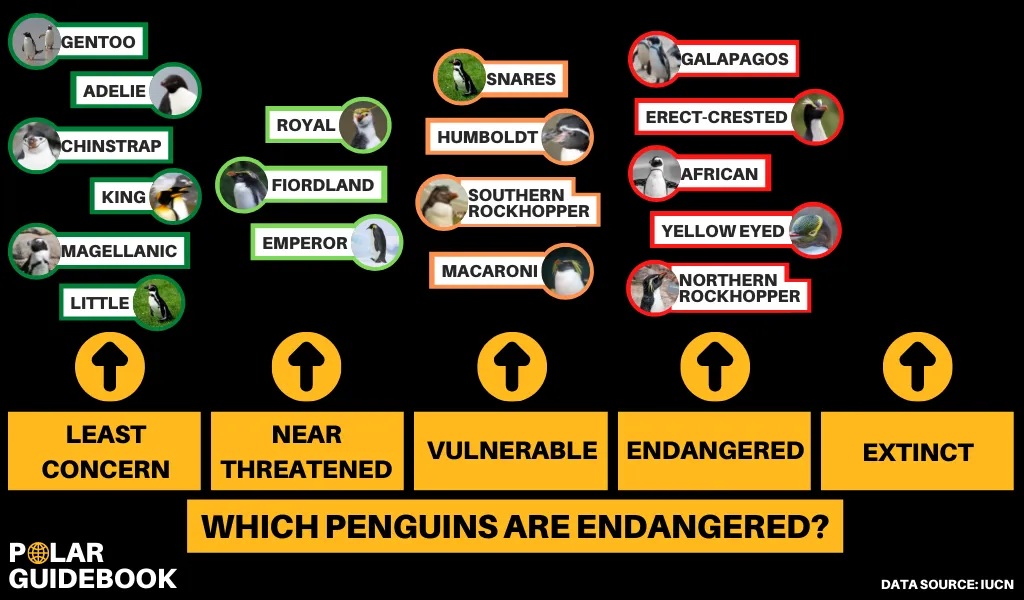
7. They are closely related to Magellanic and Humboldt Penguins
African penguins are part of a family known as banded penguins. They are very closely related to other banded penguins including Humboldt and Magellanic penguins as well as Galapagos penguins to a lesser extent.
They are so similar that some people question whether Magellanic, African, and Humboldt penguins are different species or not. Especially given that they interbreed together in captivity.
8. African penguins can dive up to 85m
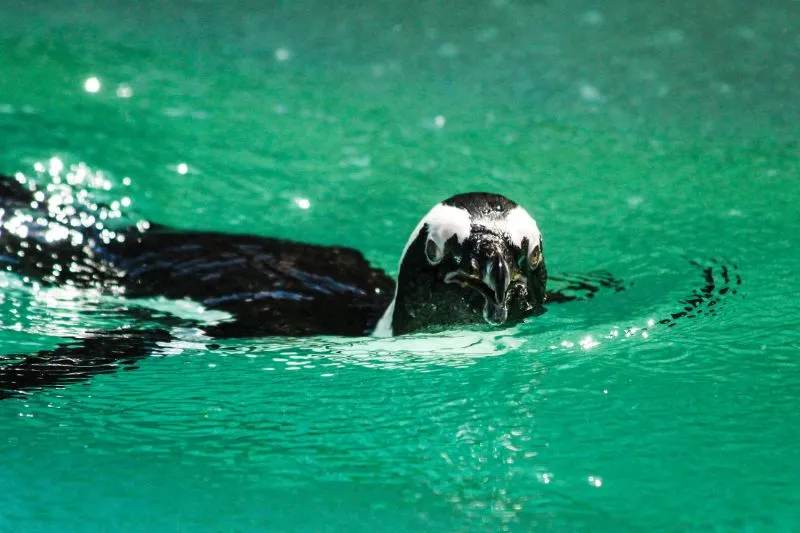
Penguins may spend around 75% of their day-to-day life in the ocean and use it as a hunting ground for catching prey8 (source: S. Moss, Do Birds Have Knees, 2016). So they must be good at diving.
African Penguins can dive to 85m with a single dive lasting for up to 2.5 minutes. However, the average dive depth when foraging is about 30m9 (sources: Journal of Experimental Biology and Penguins: Natural History and Conservation).
9. They are able to drink salt water thanks to a special salt gland
African penguins spend most of their lives at sea or around coastal areas where the only water available for consumption is saltwater.
However, their kidney is not very efficient at processing salt so they have evolved a salt gland (also known as a super orbital gland) near their eye, which removes salt from their blood. The salt is removed in water droplets through their nostrils by sneezing or shaking their head10 (source: Britannica).
This means that penguins don’t need to worry about ingesting salt water as they catch and eat their prey in the sea.
African penguins have a smaller salt gland than most other species. This is because they have a higher proportion of fish in their diet which is far less salty than the marine invertebrates which are more prevalent in the diet of other species11 (source: S.L. Hauserman, et al., The Smithsonian Institution).
10. They dig burrows in sand or poop
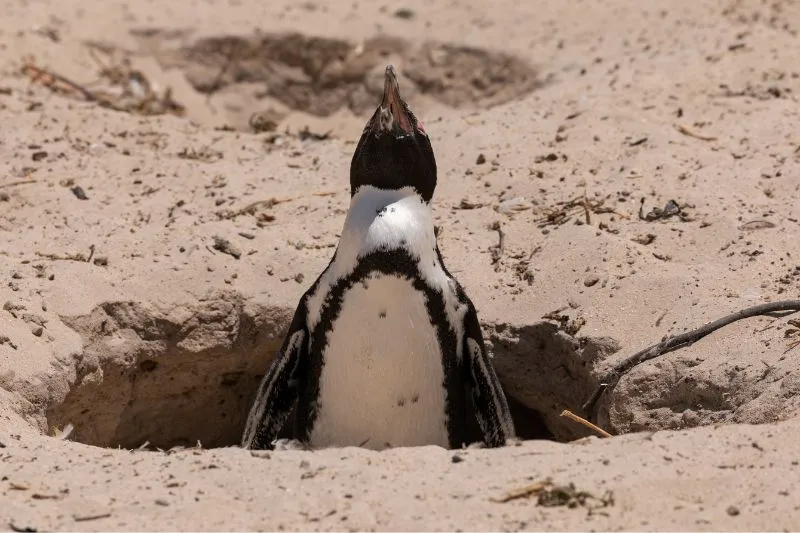
African penguins do not build traditional nests on the surface like other species of penguins because they would be too exposed to the sun and predators such as gulls.
Instead, they build burrows into sand or guano which is the accumulated poop of seabirds, including penguins themselves. They push backward with their feet to dig the burrow and may line it with seaweed, vegetation, rocks, shells, and feathers. This is where they will lay and incubate the eggs.
Guano is a sought-after product by humans since it is a highly effective fertilizer and is also used in the production of gunpowder and explosives12 (source: Wikipedia).
Unfortunately, over-exploitation of guano has had an impact on African penguin numbers as it reduces the availability of good nesting areas and guano miners trample and destroy burrows while collecting it.
11. They are known to be in same-sex couples
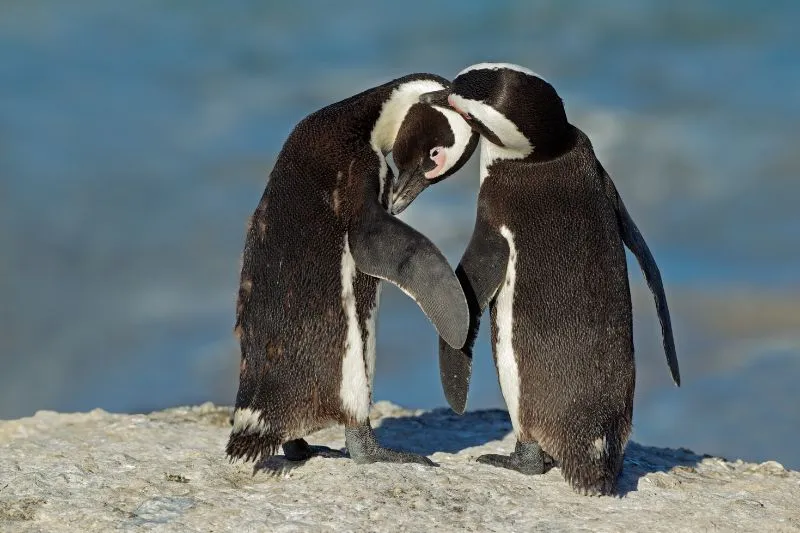
Like many other types of penguins, African penguins can be in same-sex couples in both the wild and captivity.
For example, Buddy and Pedro were a famous couple at Toronto Zoo. However, both are now in heterosexual couples and have fathered chicks13 (source: BBC). It is very common for penguins in same-sex couples to eventually become part of a straight couple.
Gay penguins are known to try and steal eggs from straight couples or sometimes they try to hatch rocks. Read our full article on whether penguins can be gay to find out how zoo keepers are responding.
12. They mostly eat fish and can consume up to 14% of their body weight each day
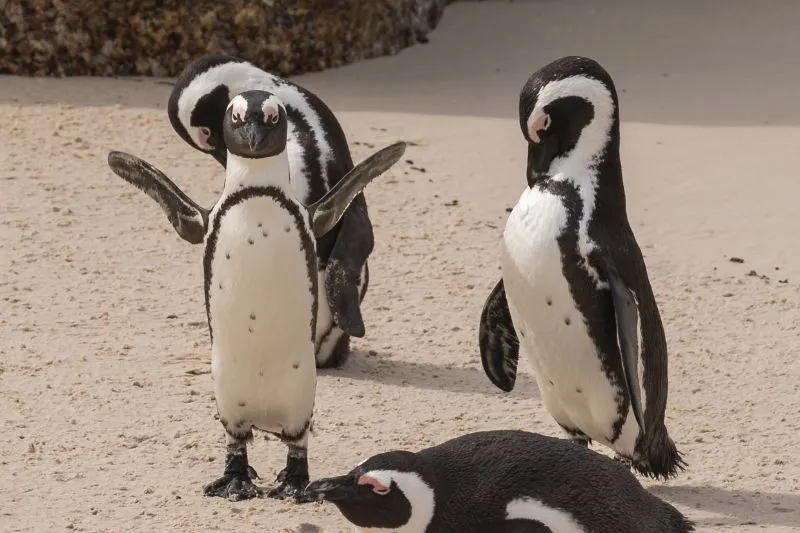
The main prey of African penguins is schooling pelagic fish including anchovies, sardines, and bearded goby. They might also eat cephalopods (such as squid), mackerel, hake, and redeye.
When foraging for food, they may do so alone or in groups of anywhere between 25–165 penguins. They are also known to hunt with other birds including Cape Gannets and Cape Cormorants, this is known as a multispecies feeding flock14 (source: P.G. Ryan, Ardea -Wageningenm, Vol. 100, No. 1, 2012).
An African penguin can eat up to 450g (1lb) of food per day which is equivalent to 14% of its body weight15 (source: Live Science). This would be like an average 91kg (200lb) adult male eating over 140 chicken wings each day16 (source: Reference.com). This amount can almost double when they are feeding younger chicks or preparing to molt.
See our full guide to find out more about what penguins eat.
13. Their main predators are sharks, gulls, and seals
The main predators of African penguins are great white sharks, kelp gulls, and cape fur seals.
Although cape fur seal attacks on African penguins are occasional and only in certain areas when they do happen they can be detrimental to colonies and have resulted in up to 25 penguins killed in a single day17 (source: University of Cape Town).
Other potential land predators include caracals, mongoose, genets, and otters. Feral cats and domestic dogs are also a risk to penguin eggs and young chicks18 (source: Penguins: Natural History and Conservation).
14. They have unique dots on their chest to identify one another (like a human’s fingerprint)
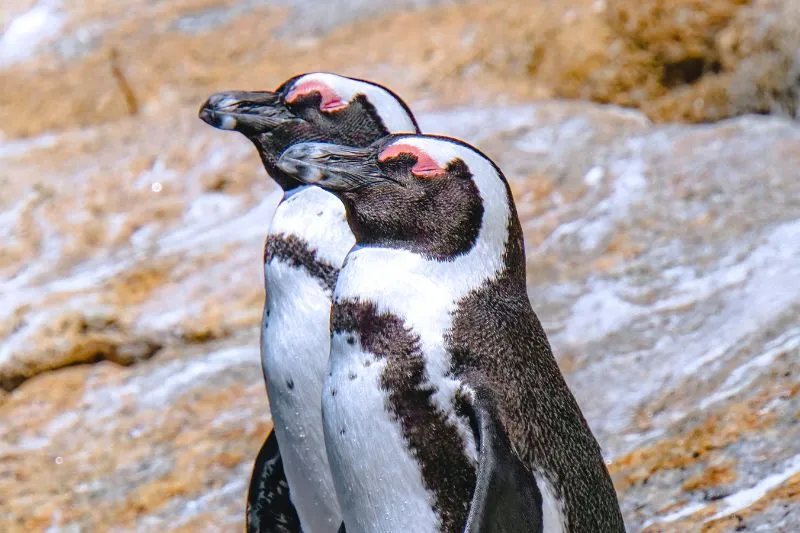
African penguins are similar in appearance to the other banded penguins with a black band that runs around the outside of their white belly.
You can distinguish African penguins from other banded penguins because they have a pink patch above their eyes which is used to dispel heat when they get too hot, as well as a particularly sharp beak.
They also have a pattern of black dots on their belly. Each penguin has a unique dot pattern, similar to how humans have unique fingerprints, which they can use to identify each other19 (source: Center for Biological Diversity).
15. They can push their feathers outwards to release heat
Living in the temperate climate of Africa brings many challenges for penguins where high temperatures can cause heat stress and may result in nests, eggs, and chicks being abandoned20 (source: The Globe and Mail). Luckily, African penguins can change their behavior and have several adaptations that allow them to deal with these conditions.
They are smart at avoiding the heat. They build their nests in the shade and tend to avoid being in the sun during the hottest parts of the day.
They have patches of bare skin above their eyes which allows blood to circulate through and cool down. They also have a unique muscle adaptation that allows them to hold their feathers outwards and release trapped heat.


![You are currently viewing 15 Amazing Facts About African Penguins [#9 Might Make You Squirm]](https://polarguidebook.com/wp-content/uploads/2023/01/African-Penguin-1.jpg)
![Read more about the article 12 Fascinating Facts About Fiordland Penguins [#4 is Hard to Believe]](https://polarguidebook.com/wp-content/uploads/2023/01/Fiordland-Penguin-2-300x200.jpg)

![Read more about the article Are Penguins Nocturnal? [Where + How They Sleep]](https://polarguidebook.com/wp-content/uploads/2022/01/Sleeping-Penguins-300x176.jpg)